CS 348 Introduction to Database Management
Contents
- Introduction to databases
- The relational model
- Introduction to SQL
- Applications and SQL
- Entity relationship model
- ER to RDB mapping
- Normal Forms and Dependencies
- Query and Update Evaluation
- Concurrent Access to Data and Durability
- Database Tuning
Introduction to databases
database: large and persistent collection of factual data and metadata organized to facilitate efficient retrieval and revision
data model: determines the nature of the metadata and how retrieval and revision is expressed
database management system (DBMS): program (or set of programs) that implements a data model
schema: collection of metadata conforming to an underlying data model
database instance: collection of factual data as defined by a given database schema
Three level schema architecture
external schema (view): what application programs and user see
conceptual schema: description of logical structure of all data in database
physical schema: description of physical aspects (files, devices, storage algorithms, etc)
Data independence
Idea: Applications do not access data directly but, rather through an abstract data model provided by the DBMS
physical data independence: applications immune to changes in storage structures
logical data independence: modularity
- ex. the
WAREHOUSEtable is not accessed by payroll app;EMPLOYEEtable is not accessed by inventory control app
Transaction
When multiple applications access the same data, undesirable results occur.
transaction: an application-specified atomic and durable unit of work
ACID properties:
- atomic: a transaction occurs entirely, or not at all
- consistency: each transaction preserves the consistency of the database
- isolated: concurrent transactions do not interfere with each other
- durable: once completed, a transaction’s changes are permanent
DBMS interface
data definition language (DDL): for specifying schemas
data manipulation language (DML): for specifying retrieval and revision requests
- navigational: procedural
- non-navigational: declarative
Summary
DBMS helps:
- to remove common code from applications
- to provide uniform access to data
- to guarantee data integrity
- to manage concurrent access
- to protect against system failure
- to set access policies for data
The relational model
Set comprehension for questions:
\[\{(x_1, ..., x_k) | \langle condition \rangle\}\]Answers: all k-tuples of values that satisfy \(\langle condition \rangle\)
Relational database components
universe: a set of values \(\textbf{D}\) with equality (\(=\)) defined
relation: predicate name \(R\), and arity \(k\) of \(R\) (# of columns)
- instance: a relation \(\textbf{R} \subseteq \textbf{D}^k\)
database: signature: finite set \(\rho\) of predicate names
- instance: a relation \(\textbf{R}_i\) for each \(R_i\)
signature: \(\rho = (R_1, ..., R_n)\)
instance: \(\textbf{DB} = (\textbf{D}, =, \textbf{R}_1, ..., \textbf{R}_n)\)
Simple truth
Relationships between objects (tuples) that are present in an instance are true, relationships absent are false
Conditions in relational calculus

Integrity constraints
yes/no conditions that must be true in every valid database instance
Domain independent query
domain independent query: a query \(\{(x_1, ..., x_k) \vert \phi\}\) such that
\[\textbf{DB}_1, \theta \models \phi \iff \textbf{DB}_2, \theta \models \phi\]for any pair of database instances and for all \(\theta\)
Range restricted query
range restricted formula: a formula \(\phi\) such that for \(\phi_i\) that are also range restricted, \(\phi\) has the form
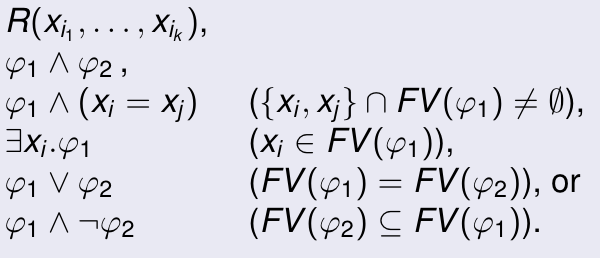
Theorem: range restricted \(\implies\) domain independent
Theorem: every domain independent query can be written equivalently as a range restricted query
What cannot be expressed in relational calculus?
RC is not turing complete
It cannot express:
- built in operations (ordering, arithmetic, string operations, etc)
- counting/aggregation (cardinality of sets)
- reachability/connectivity (paths in a graph)
Introduction to SQL
TODO
Applications and SQL
TODO
Entity relationship model
ER model
World described in terms of
- entities: distinguishable object
- attributes: describe properties of entities or relationships
- relationships: represent certain entities are related to eachother
Examples:
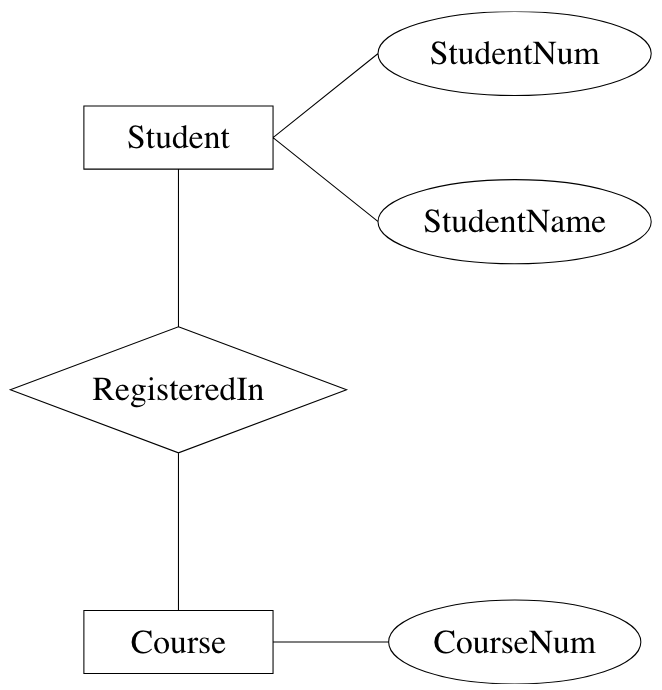
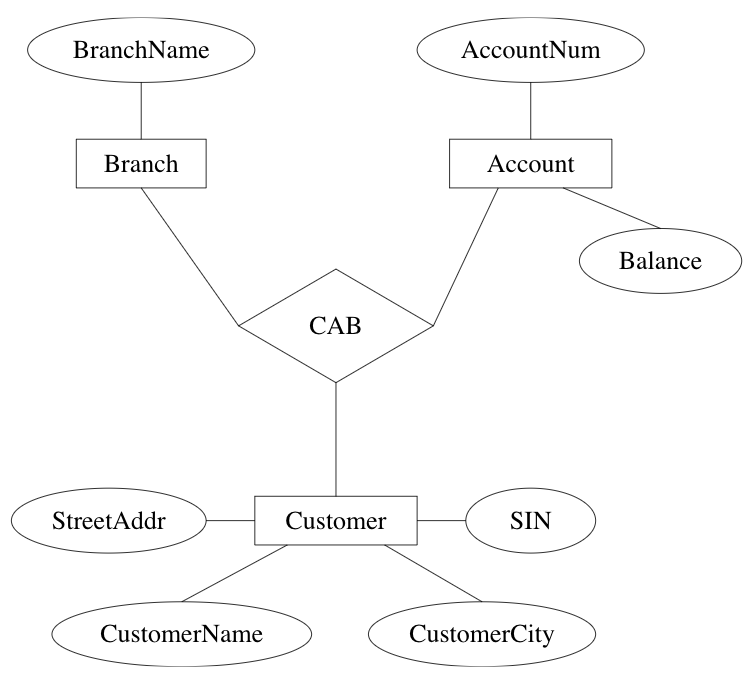
role: function of an entity set in a relationship set
- required when entity set has multiple functions in a relationship set
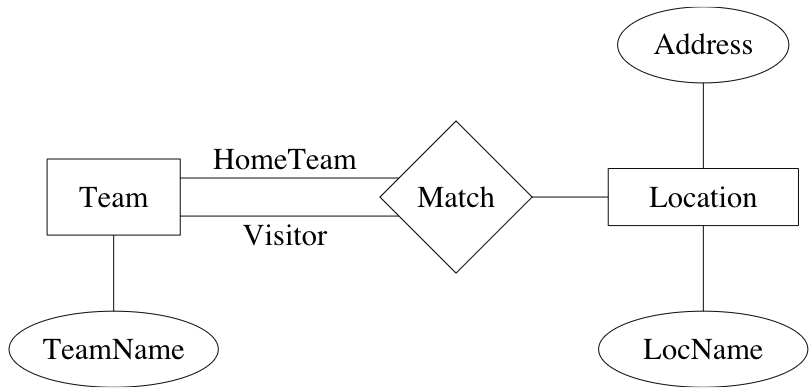
primary key: selection of attributes whose values determine a particular entity
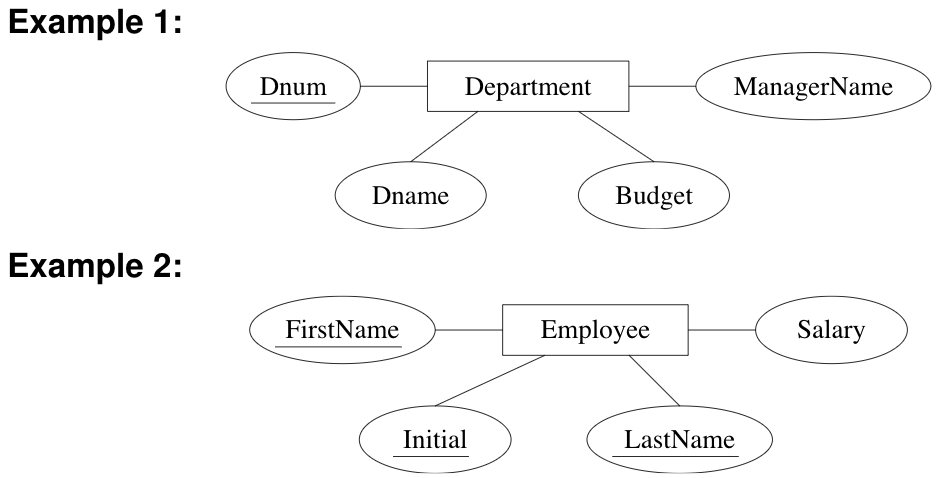
many-to-many (n:n): entity in one set related to many entities in other set, and vice versa (default)
many-to-one (n:1), one-to-many (1:n): entity in one set can be related to at most one entity in the other

one-to-one (1:1): obvious

existence dependency: if x is existence dependent on y, then
- y is a dominant entity
- x is a subordinate entity
weak entity set: entity set containing subordinate entities
- must have a n:1 relationship to a distinct entity set
strong entity set: entity set containing no subordinate entities
Example: transactions are existence dependent on accounts. All transactions for a given account have a unique transaction number
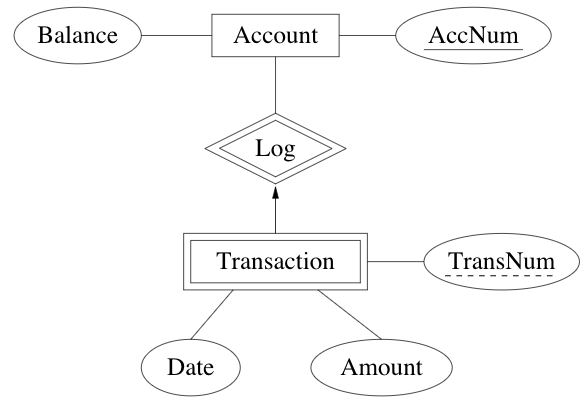
discriminator of a weak entity set: set of attributes that distinguish subordinate entities of the set, for a particular dominant entity
- primary key for a weak entity set: discriminator + primary key of entity set for dominant entities
Extensions to E-R modeling
structured attributes
- composite attributes: composed of fixed # of other attributes
- multi-valued attributes: attributes that are set-valued
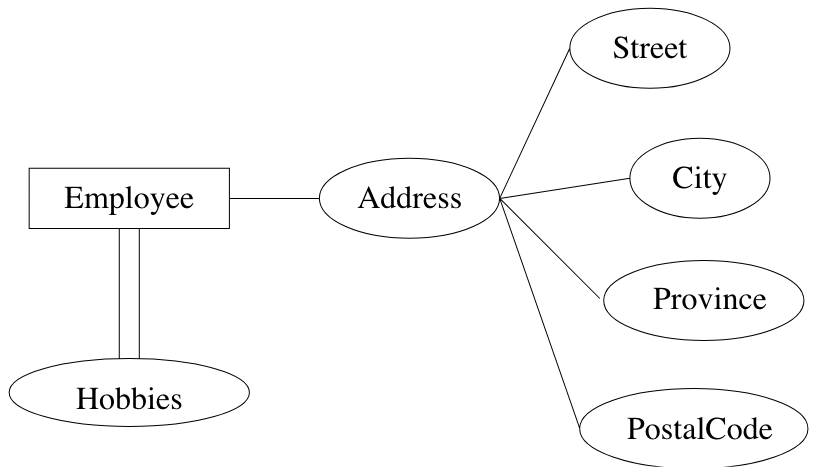
aggregation: view relationship as higher level entity
Example: accounts are assigned to a given student enrollment
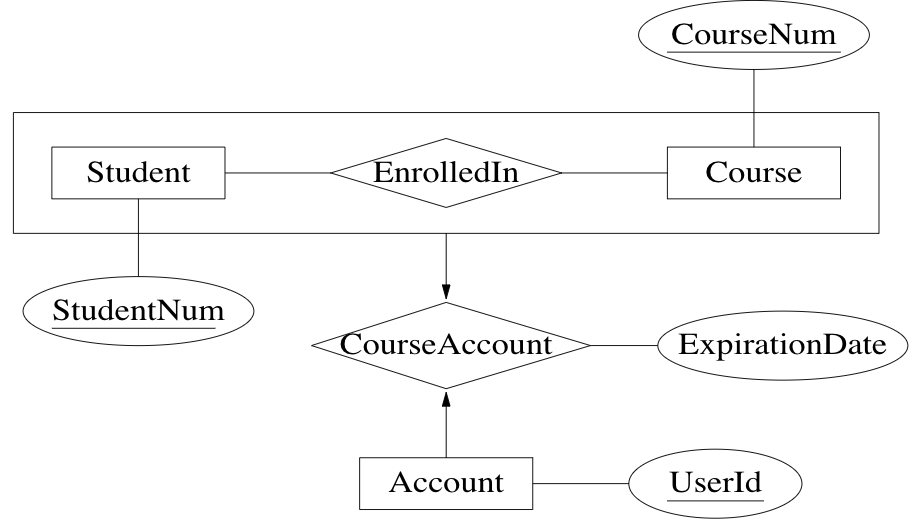
specialization: specialized kind of entity set may be derived from a given entity set
Example: grad students are students who have a supervisor and a # of degrees
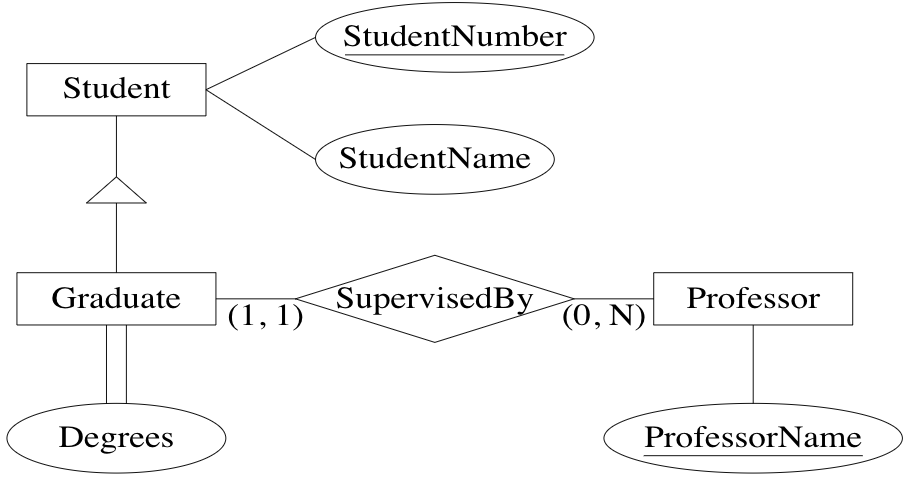
generalization: several entity sets can be abstracted by a more general entity set
Example: vehicle abstracts the notion of a car and a truck
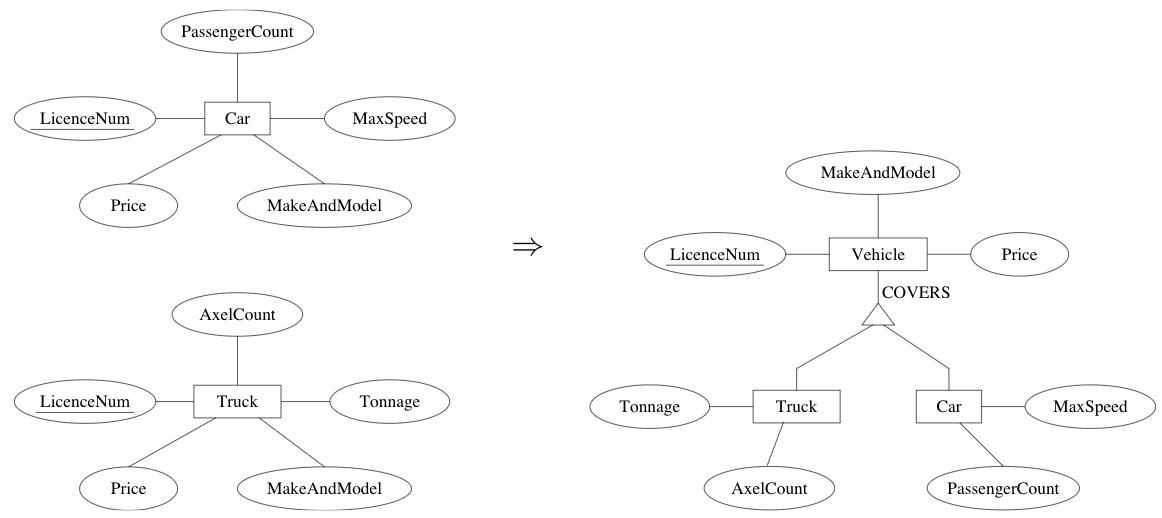
disjointness: specialized entity sets are usually disjoint but can be declared to have entities in common
Example: to accommodate utility vehicles, they can be both a car and truck via OVERLAPS
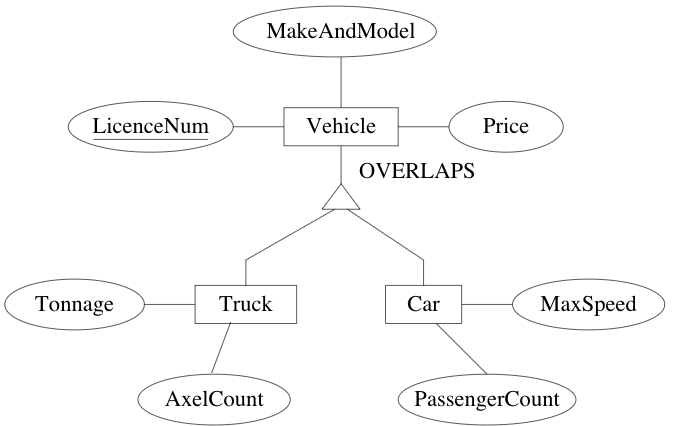
Exampe: registrar database
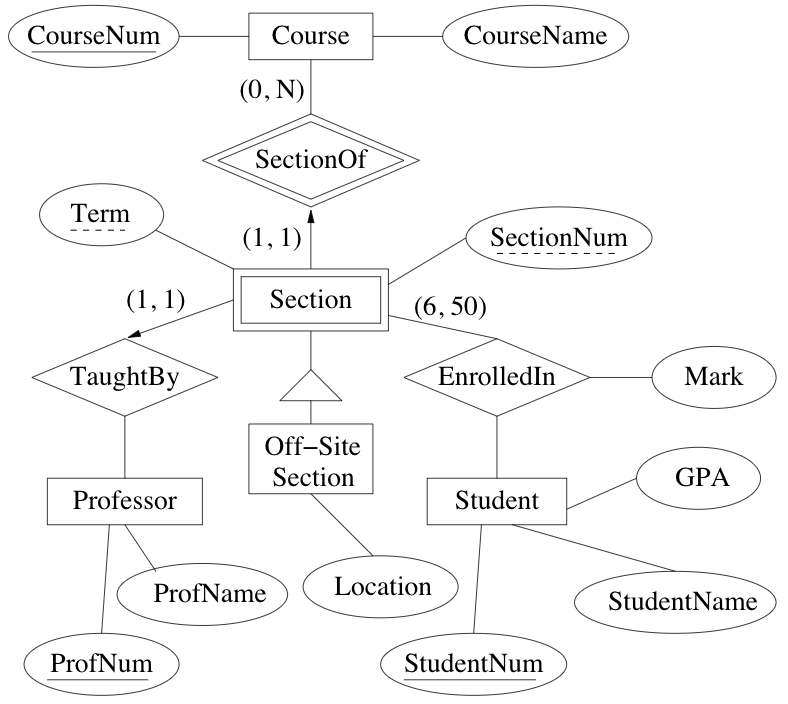
END OF MIDTERM CONTENT
ER to RDB mapping
Normal Forms and Dependencies
Anomalies
Problems that occur in poorly planned, un-normalized databases where all data is stored in one table.
insertion anomaly: impossible to add a piece of data without adding a related piece of data
- ex. library db cannot create a new member until he/she takes out a book
deletion anomaly: a piece of data may be validly deleted, causing the unintentional deletion of another piece of related data
- ex. deleting the last loan of a book may delete all information about the book from the database
Functional Dependencies
Expresses the fact that in a relational schema, the values of a set of attributes uniquely determines the values of another set of attributes.
Notation: \(X \rightarrow Y\) means \(X\) functionally determines \(Y\)
Example:

- SIN \(\rightarrow\) EName
- PNum \(\rightarrow\) PName, PLoc
- PLoc, Hours \(\rightarrow\) Allowance
Implication for FDs
A set \(F\) logically implies a FD \(X \rightarrow Y\) if \(X \rightarrow Y\) holds in all instances of \(R\) that satisfy \(F\).
Closure \(F^+\) of \(F\) is the set of all FDs that are logically implied by \(F\).
- then \(F \subseteq F^+\)
Example: If \(F = \{A \rightarrow B, B \rightarrow C\}\), then \(F^+ = \{A \rightarrow B, B \rightarrow C, A \rightarrow C\}\)
Armstrong’s axioms
reflexivity: \(Y \subseteq X \implies X \rightarrow Y\)
augmentation: \(X \rightarrow Y \implies XZ \rightarrow YZ\)
transitivity: \(X \rightarrow Y, Y \rightarrow Z \implies X \rightarrow Z\)
These axioms are
- sound: anything derived from \(F\) is in \(F^+\) (ie. anything you can prove is correct)
- complete: anything in \(F^+\) can be derived (ie. anything that is correct can be proved)
Additional derived rules:
union: \(X \rightarrow Y, X \rightarrow Z \implies X \rightarrow YZ\)
decomposition: \(X \rightarrow YZ \implies X \rightarrow Y\)
Example:
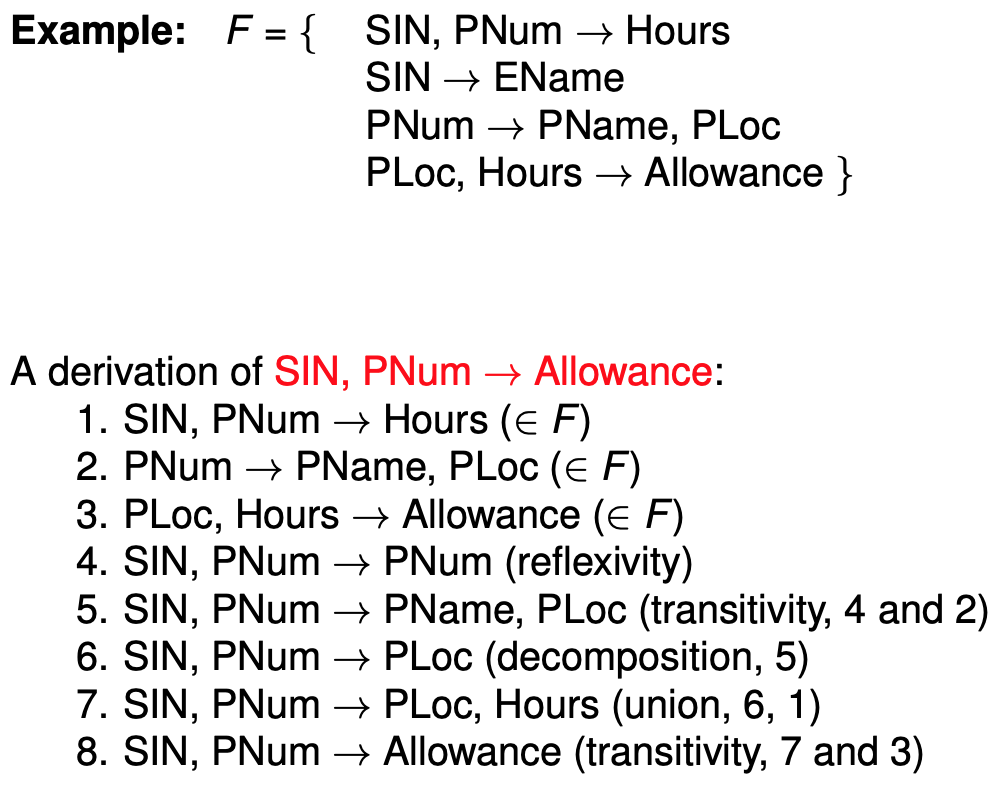
Keys
\(K \subseteq R\) is a superkey for relation schema \(R\) if dependency \(K \rightarrow R\) holds on \(R\)
\(K \subseteq R\) is a candidate key for relation schema \(R\) if \(K\) is a superkey and no subset of \(K\) is a superkey
primary key: a chosen candidate key
Decompositions
The collection \(\{R_1,...,R_n\}\) of relation schemas is a decomposition of relation schema \(R\) (= set of attribute) if
\[R = R_1 \cup ... \cup R_n\]Good decompositions
- do not lose information
- do not complicate checking of constraints
- do not contain anomalies
Lossless-Join Decompositions
A decomposition \(\{R_1, R_2\}\) of \(R\) is lossless iff the common attributes of \(R_1\) and \(R_2\) form a superkey for either schema, that is
\[R_1 \cap R_2 \rightarrow R_1 \vee R_1 \cap R_2 \rightarrow R_2\]In other words, re-joining the decomposition always produces the exact same tuples as in the original relation \(R\).
Example:
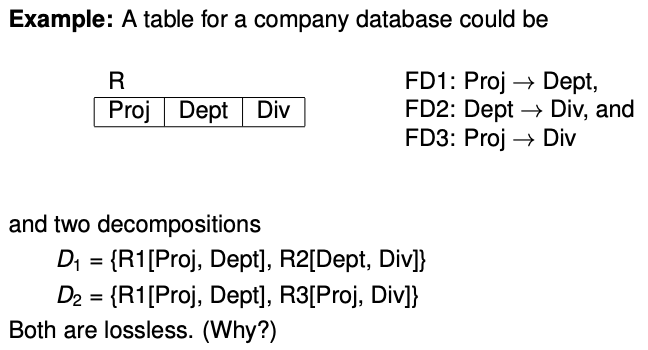
- \(R_1 \cap R_2\) (= Dept) is a superkey of \(R_2\)
- \(R_1 \cap R_2\) (= Proj) is a superkey of both \(R_1\) and \(R_3\)
- decomposition \(D_1\) is better because FD1 and FD2 can be tested on the two separate tables. FD3 then follows from transitivity. FD2 is an interrelational constraint in decomposition \(D_2\) because testing it requires joining tables \(R_1\) and \(R_3\)
A decomposition \(D = \{R_1, ..., R_n\}\) is dependency preserving if there is an equivalent set \(F'\) of FDs, none of which is interrelational in \(D\).
Normal forms
Boyce-Codd Normal Form (BCNF)
Schema \(R\) is in BCNF w.r.t. \(F\) iff whenever \(X \rightarrow Y \in F^+\) and \(XY \subseteq R\) then either
- \(X \rightarrow Y\) is trivial (ie. \(Y \subseteq X\)), or
- \(X\) is a superkey of \(R\)
Formalizes the goal that independent relationships are stored in separate tables.
Third Normal Form (3NF)
Schema \(R\) is in 3NF w.r.t. \(F\) iff whenever \(X \rightarrow Y \in F^+\) and \(XY \subseteq R\) then either
- \(X \rightarrow Y\) is trivial (ie. \(Y \subseteq X\)), or
- \(X\) is a superkey of \(R\), or
- each attribute of \(Y\) contained in a candidate key of \(R\)
First Normal Form
All data in cells is atomic.
Query and Update Evaluation
How are queries executed?
- parsing, typechecking, etc
- relational calculus (SQL) translated to relational algebra
- optimization: efficient query plan, statistics collected about stored data
- plan execution: access methods access relations, physical relational operators combine relations
Relational Algebra
Constants:
- \(R_i\) one for each relational scheme
Unary operators:
- \(\sigma_\varphi\) selection (filter tuples satisfying \(\varphi\),
WHERE) - \(\pi_V\) projection (keep attributes in \(V\), like
SELECT)
Binary operators:
- \(\times\) Cartesian product
- \(\cup\) union
- \(-\) set difference
Theorem: for every domain independent relational calculus query there is an equivalent relational algebra expression
Iterator Model
Avoid storing intermediate results by using cursor OPEN/FETCH/CLOSE interface.
Each implementation of a relational algebra operator:
- implements the cursor interface to produce answers
- uses the same interface to get answers from its children
Implementations
- selection: check filter condition on fetch of child
- projection: eliminate unwanted attributes from each tuple
- product: simple nested loops, followed by dedup
- union: simple concatenation, followed by dedup
- set difference: nested loops checking for tuples on r.h.s.
Naive implementations are slow, speed up using:
- data structures for efficient searching (indexing)
- better algorithms based on sorting/hashing
- rewrite RA expr
When index \(R_{index}(x)\) is available, we replace a subquery \(\sigma_{x=c}(R)\) with accessing \(R_{index}(x)\) directly.
Even if index is available, scanning entire relation may be faster if:
- relation is very small
- relation is large, but most of the tuples are expected to satisfy the selection criterion
Plans
Generate all physical plans equivalent to the query, and pick the one with the lowest cost.
Simple cost model for disk I/O:
- uniformity: all possible values of an attribute are equally likely to appear in a relation
- independence: likelihood an attribute has a particular value in a tuple does not depend on values of other attributes
For a stored relation \(R\) and attribute \(A\) we keep the following to estimate the cost of physical plans:
- \(\mid R \mid\): cardinality of \(R\)
- \(b(R)\): blocking factor of \(R\)
- \(\min(R,A)\): minimum value for \(A\) in \(R\)
- \(\max(R,A)\): maximum value for \(A\) in \(R\)
- \(\text{distinct}(R,A)\): number of distinct values of \(A\)
Cost of specific operations…
Plan generation…
Concurrent Access to Data and Durability
DB implementation has two parts:
- concurrency control: guarantees consistency and isolation
- recovery management: guarantees atomicity and durability
Notation
\(r_i[x]\): transaction \(T_i\) reads object \(x\)
\(w_i[x]\): transaction \(T_i\) writes object \(x\)
Transaction \(T_i\) is a sequence of operations: \(T_i = r_i[x_1], r_i[x_2], w[x_1], c_i\)
\(c_i\): commit request of \(T_i\)
For a set of transactions \(T_1, ..., T_k\), we want to produce a schedule \(S\) of operations such that
- every operation \(o_i \in T_i\) also appears in \(S\)
- \(T_i\)’s operations in \(S\) are ordered as they are in \(T_i\)
Serializability
Goal: produce a correct schedule with maximal parallelism
- correctness: must appear as if the transactions have been executed sequentially
An execution of \(S\) is serializable if it is equivalent to a serial execution of the same transactions.
Example:
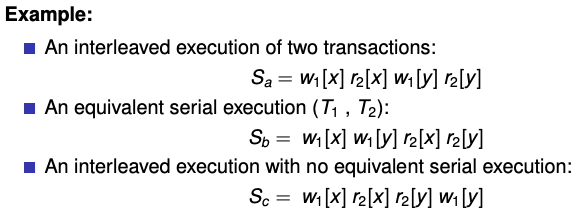
recoverable schedule: no operations are non-recoverable
cascadeless schedule (ACA): does not have cascading abort
- if \(w_i[x], ..., r_j[x]\) then must also have \(c_i, ..., c_j\)
- every cascadeless schedule is also recoverable
For every operation that a scheduler receives from a query processor, it can:
- execute it: send to lower module
- delay it: insert to queue
- reject it: cause abort of transaction
- ignore it: no effect
conservative scheduler: favours delaying operations
aggressive scheduler: favours rejecting operations
Two Phase Locking (2PL)
Transactions must have a lock on objects before access
- shared lock for reading an object
- exclusive lock for writing an object
2PL protocol: transaction has to acquire all locks before it releases any of them
Theorem: 2PL guarantees the produced transaction schedules are (conflict) serializable
STRICT 2PL: locks held until commit, avoids cascading aborts (ACA)
Isolation Levels in SQL
4 isolation levels:
- level 3 (serializability): table-level strict 2PL
- level 2 (repeatable read): tuple-level strict 2PL
- phantom tuple may occur (results from insert/delete during “all records” query)
- level 1 (cursor stability): tuple-level exclusive-lock only strict 2PL
- reading same object twice may result in different values
- level 0: neither read nor write locks are required, transaction may read uncommitted updates
Recovery
Goals:
- allow transactions to be
- committed: with a guarantee that the effects are permanent, or
- aborted: with a guarantee that the effects disappear
- allow the database to be recovered to a consistent state in case of HW failure
Approaches to recovery:
- shadowing
- copy-on-write and merge-on-commit
- poor clustering
- not used in modern systems
- logging
- use of log (separate disk) to avoid forced writes
- utilization of buffers
- preserves original clusters
Log Based Approaches
Logs are read/append only, and transactions add log records about what they do.
Types of information:
- UNDO: old versions of modified objects, used to undo changes made by a transaction which aborts
- REDO: new versions of modified objects, used to redo changes made by a transaction which commits
- BEGIN/COMMIT/ABORT: recorded whenever a transaction changes into one of these states
Log example:
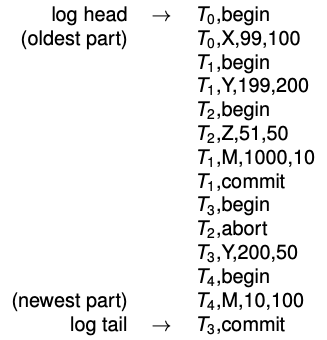
To ensure the log is consistent with main database, use write ahead log (WAL). Requires:
- UNDO rule: a log record for an update is written to log disk before the corresponding data is written to the main disk
- guarantees atomicity
- REDO rule: all log records for a transaction are written to log disk before commit
- guarantees durability
Database Tuning
physical design: process of selecting physical schema (data structures) to implement a conceptual schema
tuning: periodically adjusting physical or conceptual schema to adapt to requirements via:
- making queries run faster
- making updates run faster
- minimizing congestion due to concurrency
Both of the above rely on understanding the workload.
workload description includes:
- most important queries/updates and their frequency
- desired performance goal for each query/update
- include the relations/attributes accessed/retrieved, selectiveness of join conditions
Physical Schema
Storage strategy for each relation. Possible options:
- unsorted (heap) file
- sorted file
- hash file
Add indexes which:
- speed up queries
- increase update overhead
Indexes
Create/drop syntax:
CREATE INDEX LastnameIndex
ON Employee(Lastname) [CLUSTER]
DROP INDEX LastnameIndex
Effects of index:
- reduce execution time for selections with conditions involving
Lastname - increase insertion execution time
- increase or decrease execution time for updates or deletions of rows
- increase amount of space required to represent
Employee
An index on attribute \(A\) of a relation is clustering if tuples with similar values for \(A\) are stored together in the same block.
Other indices are non-clustering.
A relation has at most one clustering index.
Two relations are co-clustered if their tuples are interleaved within the same file.
- useful for hierarchical data (1:n relationship)
- can speed up joins (particularly foreign key join)
- sequential scans of either relation slow down
Creating multi-attribute index:
CREATE INDEX NameIndex
ON Employee(Lastname, Firstname)
- tuples are organized first by
Lastname, thenFirstname - useful for:
SELECT * FROM Employee WHERE Lastname = 'Smith' SELECT * FROM Employee WHERE Lastname = 'Smith' AND Firstname = 'John' - extremely useful for:
SELECT Firstname FROM Employee WHERE Lastname = 'Smith' SELECT Firstname, Lastname FROM Employee - not useful at all for
SELECT * FROM Employee WHERE Firstname = 'John'
Tuning the Conceptual Schema
Unlike physical schema changes, conceptual schema changes often can’t be completely masked from end users.
normalization: process of decomposing schemas to reduce redundancy
denormalization: process of merging schemas to intentionally increase redundancy
Generally redundancy increases update overhead due to change anomalies, but decreases query overhead (due to less joins?).
partitioning: of a table means to split it into multiple tables to reduce bottlenecks
- horizontal: each partition has all the original columns and a subset of original rows
- separates operational from archival data
- vertical: each partition has a subset of original columns and all the original rows
- separates frequently used columns from eachother or from infrequently used columns
Tuning Queries
Physical and conceptual schema changes impact all queries.
Guidelines:
- sorting (
ORDER BY,DISTINCT,GROUP BY) is expensive - when possible, replace subqueries with joins
- when possible, replace correlated subqueries with uncorrelated subqueries
- use vendor tools to examine query execution plan
Tuning Applications
Guidelines:
- minimize communication costs
- return fewest columns and rows necessary
- update multiple rows with
WHERErather than a cursor
- minimize lock contention and hot spots
- delay updates and operations on hot spots as long as possible
- shorten/split transactions as much as possible
- perform insert/update/delete in batches
- consider lower isolation levels